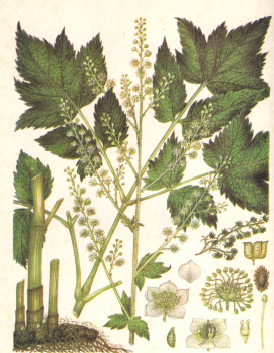A tall perennial herbaceous plant with a thick creeping rhizome; the upper side of the rhizome retains protruding remnants of stems with broken pith, and numerous long, thin roots extend downward. The lower leaves are large, on long petioles, and are many times pinnately divided; the upper stem leaves are small and sessile. The flowers are small, inconspicuous, white, and are grouped in a large terminal panicle. It flowers in July–August. It grows in Transbaikalia and the Primorye region, along forest edges and open areas. The rhizomes with roots of Cimicifuga are collected — Rhizoma cum radicibus Cimicifugae.

Chemical Composition:
The rhizomes are poorly studied chemically. Glycosides, coumarins, and resins have been found. The tincture of the rhizome and roots of Cimicifuga has hypotensive and sedative properties, and it also reduces pain sensitivity. It is used to lower blood pressure, as a sedative, and to normalize sleep.
Use:
The tincture (1:5 on 70% alcohol) is taken as a hypotensive and calming agent in the early stages of hypertension. The recommended dosage is 50–60 drops, 2–3 times a day.
